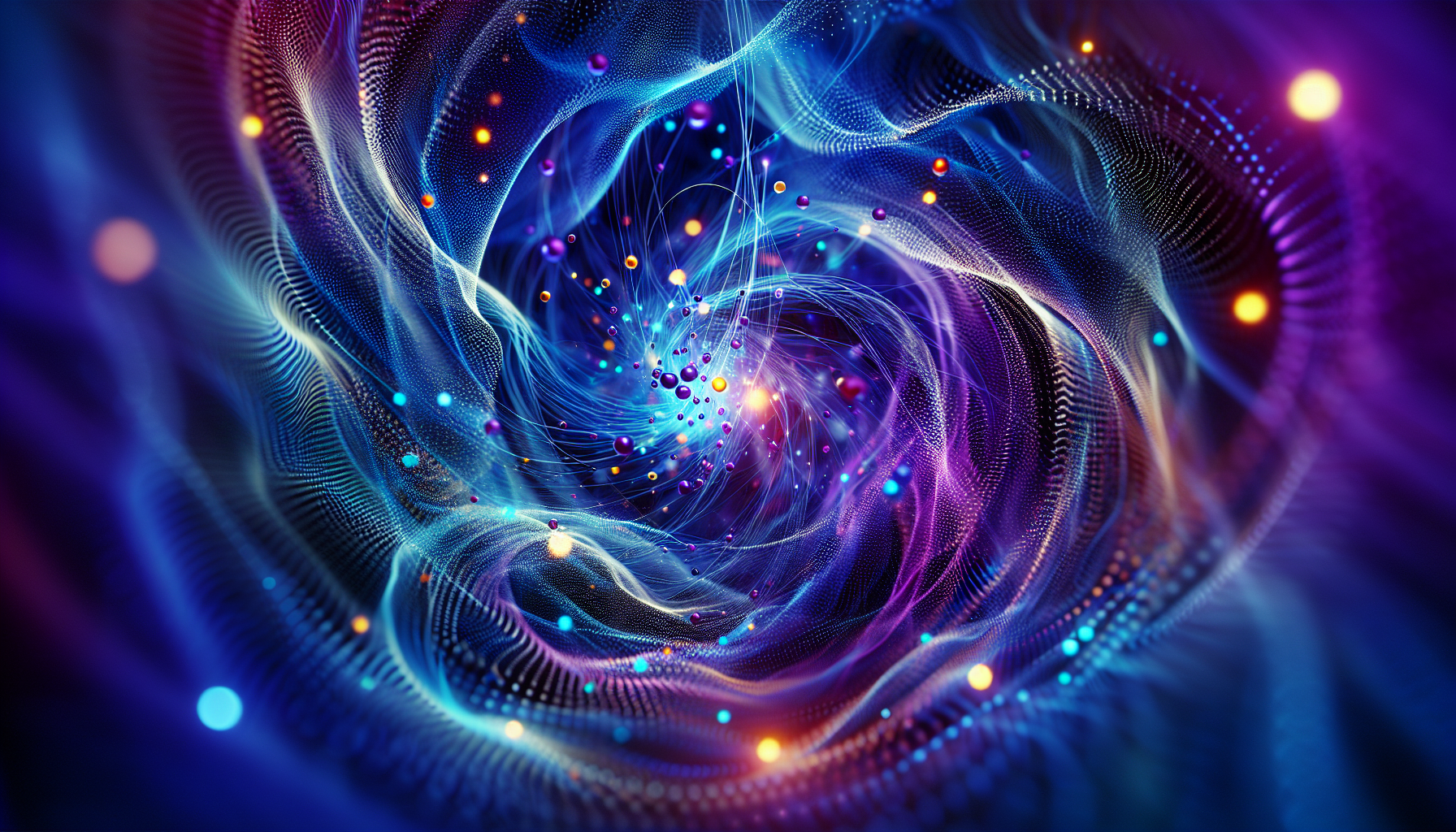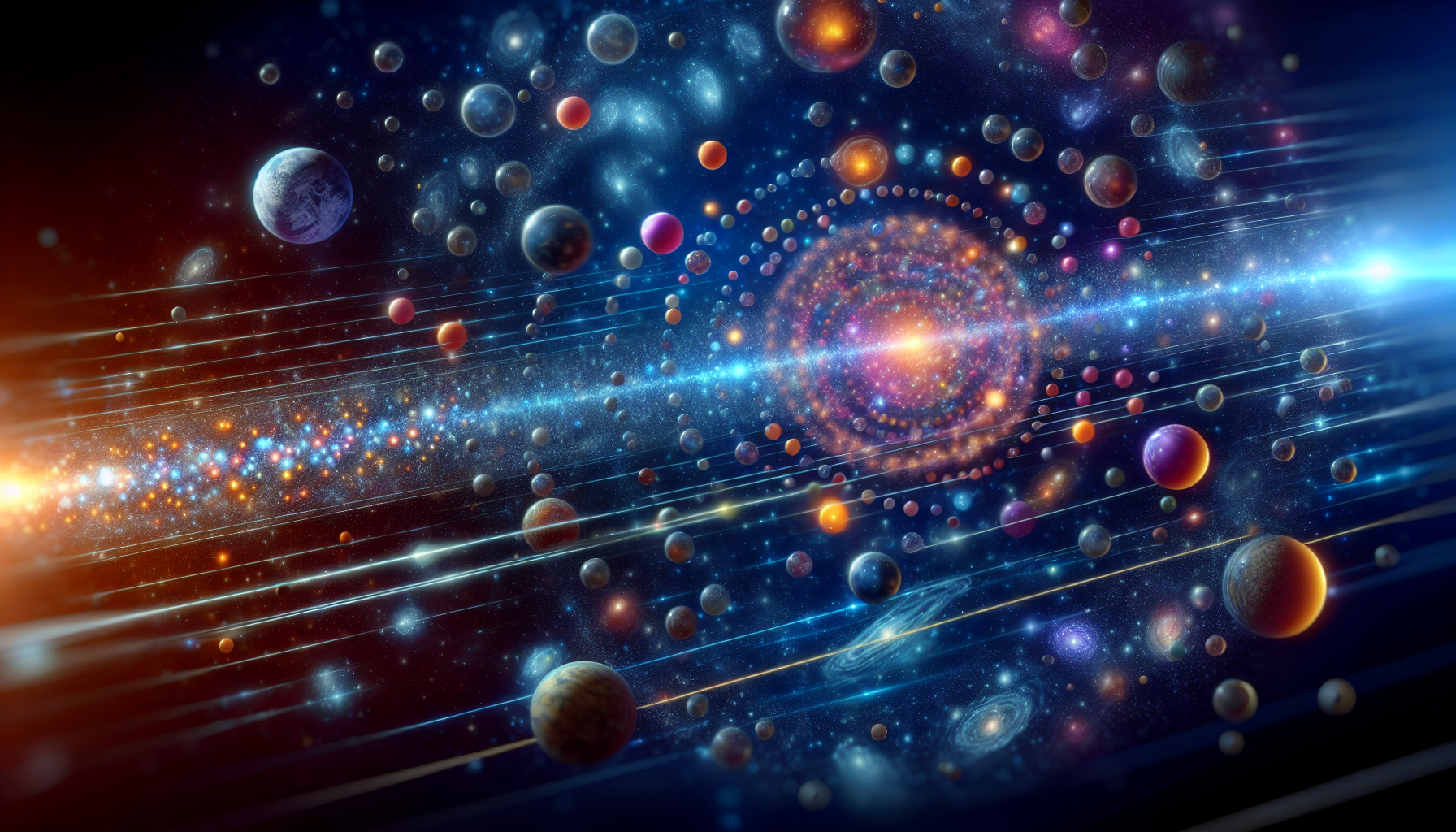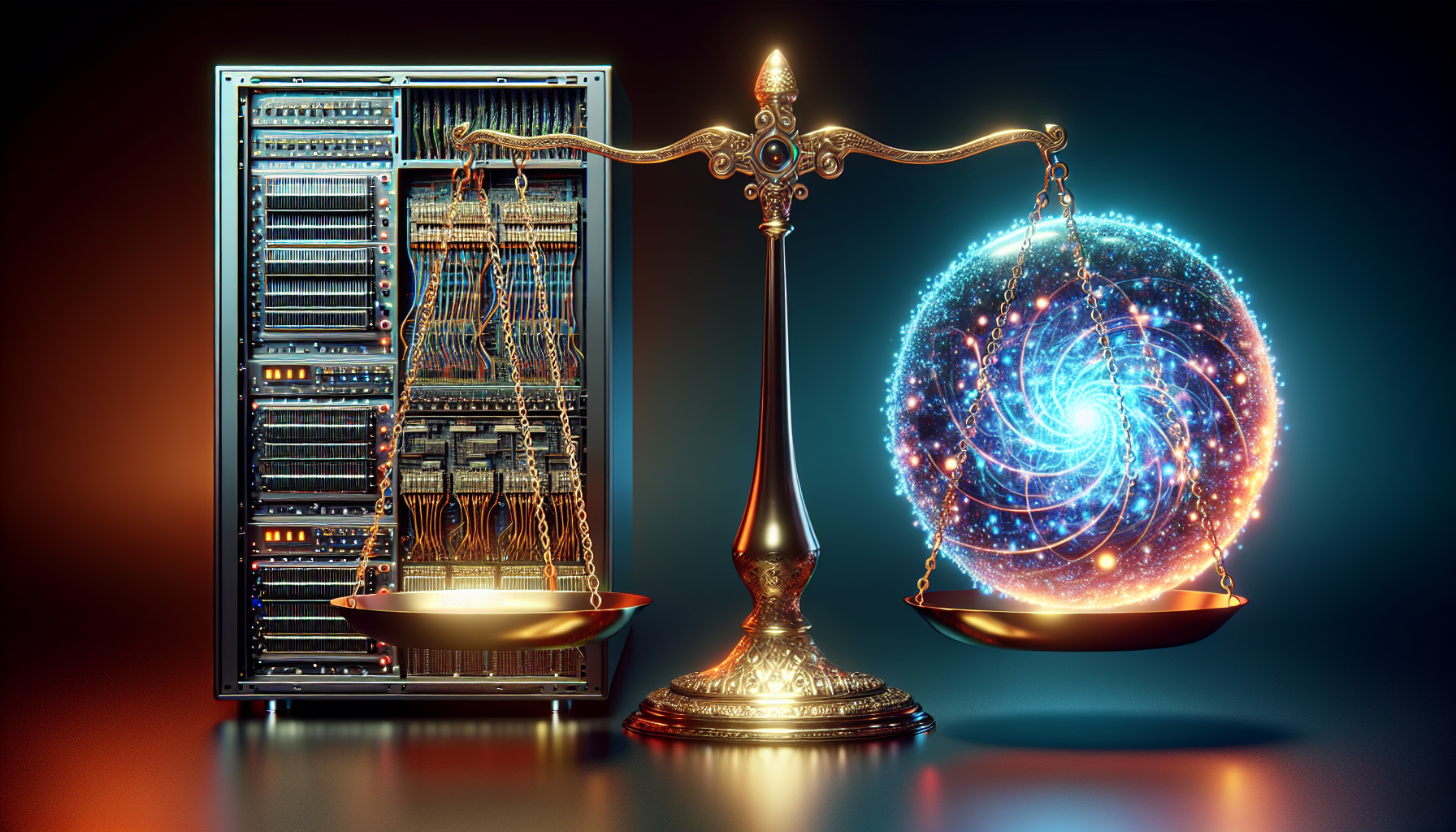At its core, “what is quantum” mechanics is the branch of physics that studies the strange behavior of particles at the atomic and subatomic levels. Unlike the predictable world of classical physics, quantum particles operate under a set of rules that challenge our understanding of reality. These rules are critical for technologies like quantum computing, where the strange properties of quantum mechanics enable machines to solve problems in ways traditional computers can’t. This article dives into what ‘quantum’ means and its far-reaching implications for science and technology.
Key Takeaways
Quantum mechanics revolutionized our understanding of matter and energy, introducing concepts such as wave-particle duality and entanglement, and is the foundation for quantum computing, which uses qubits to process information in multiple states simultaneously.
Quantum computing has the potential to outperform classical computing by solving complex problems much faster through principles like superposition and entanglement, but faces challenges like maintaining qubit coherence and scaling systems.
Applications of quantum computing span fields like chemistry and machine learning, and despite current technological infancy, significant advancement is expected, with a future impact that may revolutionize various industries.
Unveiling Quantum: The Fundamental Concept

Quantum mechanics is a branch of physics that was developed through the study of atoms in the 19th and early 20th century. This field has led to groundbreaking concepts, such as quanta – the smallest units of energy – wave particle duality, uncertainty principle, entanglement and superposition. These are all important aspects which have advanced modern physics extensively.
Particles within quantum mechanics are defined by probabilistic descriptions meaning their position cannot be precisely determined but can only be calculated using probability principles. The impact this idea had on computer science paved way for quantum computing research, which continues today showing its relevance with regards to technology development too.
The Birth of Quantum Theory
The development of quantum theory marked a revolutionary shift in physics, from the classical model to one which allowed for an advanced comprehension of energy and matter. Famous researchers like Werner Heisenberg, Wolfgang Pauli, Erwin Schrödinger, Max Planck and John von Neumann paved the way for its progress. These groundbreaking figures acknowledged that both energy and mass could be perceived as individual quanta containing at least some degree of value attached to them.
Some vital experiments were conducted including research into blackbody radiation along with photoelectric effect results demonstrating properties consistent with those associated with quantum mechanics brought us closer than ever before towards grasping atomic structure on a deeper level when compared to what was achievable through traditional methods alone previously.
Quantum theory’s evolution symbolised scientific advancement. It inspired exploratory findings such as probing different kinds of particle phenomena or fundamental forces’ interactions between components at microscopic scales, expanding our knowledge far beyond conventional principles used by physicists up until then.
Quanta: The Smallest Discrete Units
Max Planck’s introduction of quanta in 1900 fundamentally changed how we understood quantum physics. Quanta, the most microscopic components that make up matter and energy, are essential when it comes to analyzing behavior exhibited by particles on a smaller scale. Phenomena such as tunneling, photons escaping potential barriers or superfluidity can be accounted for via quantifiable units of physical entities participating in an interaction, namely quanta. This reflects both the manageable aspects but also illustrates just how vital they are when discussing topics related to light and electricity from a scientific point of view.
Quantum vs. Classical Physics
In the realm of quantum physics, particles such as electrons and photons behave in a manner unlike that seen in classical physics. They possess both particle-like properties and wave-like characteristics. Energy is quantized rather than continuous, allowing us to use it for describing minute objects like protons or electrons. Quantum mechanics stands out compared to classical Physics since it helps explain how small things move and act, whereas classical physics describes larger physical elements moving through space including projectiles or astronomical entities. In modern technology, we can observe this distinct difference between these two fields of study with lasers, electron microscopes requiring their own type of energy from quantum but macroscopic items utilizing classic principles akin to those applied to projectiles.
Quantum Particles and Their Peculiar Behavior

Quantum particles demonstrate behaviors that differ from those of their macroscopic counterparts, which is often referred to as wave-particle duality. There are two other quantum phenomena (superposition and entanglement) both portraying the unusual nature of the realm of quantum physics. Superposition enables these tiny particles to inhabit multiple states at once, while entanglement binds them together so one particle’s state can instantly alter another regardless of how far they may be apart.
Superposition and Entanglement
In classical physics, a single particle can occupy only one state at any given time. Its quantum counterpart is allowed to exist in multiple states concurrently thanks to the phenomenon of superposition. This odd ability gets even more complex with entanglement. Particles become so interconnected that changes made on one automatically affect the other regardless of their distance from each other.
These effects aren’t just interesting concepts, but are essential for building powerful and advanced quantum computers due to their extraordinary capabilities caused by these phenomena related to quantum physics.
Wave-Particle Duality
Quantum mechanics has a central concept known as wave-particle duality, which suggests that particles can possess both the characteristics of waves and particles at the same time. This notion was proposed by French physicist Louis de Broglie. It sets quantum physics apart from classical physical laws, which do not explain this dichotomy. A convincing demonstration of this is seen in what is referred to as ‘The Double Slit Experiment’: where particle behavior takes on wave features producing an interference pattern.
Wave Particle Duality isn’t just theoretical. It’s visible across many aspects of our world, including refraction and diffraction through light rays.
The Advent of Quantum Computing

By understanding the fundamental laws of quantum mechanics, we can take a peek into the world of quantum computing. Compared to classical computers which use bits to crunch information, these state-of-the-art machines depend on qubits for data processing – thanks to superposition they are able to keep multiple states simultaneously. This distinction allows them to solve certain tasks much more quickly than traditional ones could ever do. All while being smaller and faster. It is clear that with classic systems, Quantum Machines possess an incomparable efficiency making their use a powerful solution for many problems faced by today’s technology industry as well as science research fields too!
From Quantum Mechanics to Quantum Circuits
Quantum computing offers a remarkable way to transition from quantum mechanics, and one key element in the process is making use of networks called quantum circuits. This network consists of gateways for manipulating quantum parts that create computations within a computer made entirely out of quantum parts. Much like switches on an ordinary classical machine, these gates control the states such as 0 or 1 which are essentially embedded into each bit, yet they also carry with them immense power due to their capacity to be in more than one state simultaneously (known as superpositioning) offering much greater potential compared with regular computers.
Quantum Bits (Qubits) and Quantum States
Quantum computing relies on quantum bits (qubits) which are able to exist in numerous states simultaneously thanks to superposition. This enables the process of information by a quantum computer, providing it with an advantage over classical computers due to its ability to maintain multiple state combinations concurrently. The distinctiveness between this form of computations and traditional ones is that a bit’s continuous status embraces several different basic elements at any given time unlike the defined value variables used for classical ones. By having such a capability for simultaneous operation, quantum technology holds a significant benefit compared with other forms of computation available today.
Quantum Algorithms and Their Power
Quantum computing offers distinct advantages over classical computers, and quantum algorithms are a major factor in this. Algorithms such as Shor’s and Grover’s can solve difficult problems much more quickly than traditional techniques. A great example is that Shor’s algorithm can rapidly factor large numbers compared to other known methods on classical machines – but it doesn’t end there. Some questions unanswerable by regular computation may be solvable via the use of qubits. Machine learning implementations have been noticeably speeded up when deployed on quantum devices too.
Overall these advancements highlight how powerful quantum technology could be for our future applications – from time-saving problem solving power to tackling tasks beyond what was considered possible before!
Quantum Phenomena in the Macroscopic World

The strange and marvelous properties of quantum mechanics don’t just exist on the subatomic level. They can be seen in macroscopical settings as well. Superfluidity, superconductivity, and the quantum Hall effect are all visible examples that have been used to create modern technology. Even entanglement – one of the most mysterious principles from physics at a quantum scale – has been spotted at a large dimension too! These phenomena aren’t abstract theories confined to books: instead they make up an integral part of our world today.
Bridging Quantum and Classical Systems
Quantum principles are proving to have a broader application than just the quantum realm. For instance, superposition in quantum computing enables qubits to hold multiple states at one time and can increase traditional systems’ capability of calculation.
Among other advantages such as higher speed and complexity, Quantum Computing has emerged as an effective way for bringing together classical technologies with revolutionary principles of physics, enabling users to solve problems previously deemed unsolvable on conventional systems.
Quantum Principles in Everyday Technology
The principles of quantum mechanics are not exclusive to high-tech laboratories and research centers. They also impact technologies that most people take for granted. As an example, lasers rely on stimulated emission, a quantum mechanical process where atoms receive energy which causes them to emit photons in unison as light beams. Computers use transistors powered by the concept of quantum tunneling where electrons can pass through barriers controlling circuits’ activation/deactivation cycles. Even digital cameras employ the photoelectric effect (another product of Quantum physics), transforming light into electrical signals.
Quantum Computing Vs. Classical Computing

Quantum computing and classical computing are two distinct methods for processing information. While the former uses qubits which enable states to exist simultaneously due to superposition, unlike bits in a conventional computer that work linearly, quantum computers can tackle complex problems much faster than traditional ones. They allow parallel computations, simulations of quantum systems as well as optimization of intricate components plus breaking encryption algorithms too! There is difficulty when it comes to creating larger-scale quantum computers because coherence must be maintained among its many qubits at once before scaling up these kinds of systems becomes possible.
The Quantum Advantage
Quantum computers possess the ability to revolutionize computing by offering a faster solution for certain problems, known as quantum advantage. This immense potential could have wide-reaching effects in areas such as cryptography and optimization due to quantum parallelism allowing several solutions to be examined at once. This has also been useful for machine learning algorithms that help with convergence speeds of optimizations.
Achieving what is called ‘quantum supremacy’ – where quantum machines are solving issues classical ones can’t yet solve, still needs Development before becoming reality.
Challenges in Quantum Computation
The possibilities of quantum computing are immense, but the construction and performance of large-scale quantum computers has its fair share of difficulties. In order to have an accurate outcome from a given algorithm running on such machines, qubit coherence must be kept up – meaning that each qubit should remain in their intricate ‘quantum state’. Losing this linkage between states is known as decoherence and can cause errors within algorithms thus rendering them useless. The main challenges associated with keeping these connections intact stem mainly from external noise or interactions with other particles present in the environment along with imperfections during fabrication processes or control mechanisms used for implementing operations properly. Quantum error correction Complicates maintenance efforts due to the delicacy involved when manipulating multiple entangled systems at once. Something which would arise if we were wanting enough scalability out our system(s) through increased number of interconnected particles/qubits etc. It’s important to address said issues so progress towards building practical yet reliable quantum computer platforms may continue unhinderedly while allowing us to use some amazing algorithms they enable!
Practical Applications of Quantum Technologies
Quantum technology has many practical applications in various fields, and quantum computing is particularly useful for machine learning algorithms. These tools are used to optimize problem solving and analyse complex data correlation issues at a much faster rate than conventional methods. In the field of chemistry, simulations using quantum energy can provide essential solutions such as ground state preparation, estimation of energies involved with scattering or ionization processes during chemical reactions, etc. All these tasks contribute greatly towards developing new materials and drugs that would otherwise take more time when conducted through regular means.
Quantum Simulation and Chemistry
Quantum simulation provides a powerful solution in the realm of chemistry for deciphering complicated molecules and chemical reactions, as well as accurately predicting their outcomes. This technology could be useful in the future. Be used to invent new materials or drugs using quantum computers which have been adjusted into complex generative chemistry algorithms, something that will drastically expand drug discovery possibilities. An example is how researchers can capitalize on the power of quantum computing by pushing past what was previously thought possible in terms of advancements in this area.
Machine Learning and Artificial Intelligence
Quantum computing is capable of transforming machine learning and artificial intelligence in remarkable ways, as its potential advantages over classical computers are unparalleled. It can provide solutions to complicated optimization problems quicker than standard systems, help sort through intricate correlations among data points, and enable a more rapid deployment of algorithms than traditional machines allow for. And construct entirely new computational models relying on quantum processing power. Examples include the examination of genomic material, gene expression patterns, epigenetic changes involved in drug discovery activities or financial modeling initiatives – all benefitting from superior supply chain optimization enabled by quantum technologies.
The Future Landscape of Quantum Computing
Quantum computing is a fascinating technology with potential to revolutionize many industries. Organizations need to take steps now in order for them to benefit from this innovative power when the time comes. Quantum computers, and the associated algorithms, have various exciting applications which include bettering security through quantum cryptography, improving machine learning programs, expediting optimization processes, simulating systems related to chemistry or materials science research, boosting drug development speediness plus perfecting supply chain management operations.
Timeline for Quantum Progress
Although quantum computing has great potential, we must remember that it is still in its early stages. It is expected that around 5,000 of these computers will be available by 2030. The ability to tackle more complex issues may not arise until 2035 or later. Despite this, there’s no doubt that quantum computing holds a prosperous future and will have an incredible effect on our world.
Preparing for a Quantum World
Organizations cannot afford to be complacent when it comes to quantum computing and its potential value creation of up to $1.3 trillion by 2025. They must begin investing in research and personnel now due to an existing shortfall between requisite skill-sets being sought after in business, compared with those able enough for such roles – a figure likely below 50%. Such investments will pay off immensely as the world becomes increasingly reliant on quantum technology over time.
Summary
Quantum computing has taken us on a journey from its foundations in quantum mechanics to the forefront of technology. Through our exploration, we have been able to observe how natural phenomena manifest themselves macroscopically and utilize those principles for improving traditional technologies. Practical applications of these advances are evident within chemistry and machine learning processes too. Looking ahead at what this new way of understanding could do for our world is an exciting prospect that leads only towards unlocking the full potentials offered by quantum computing.
Frequently Asked Questions
What is a quantum in simple terms?
The term “quantum” originates from the Latin word meaning “how much” and it is used to describe a smallest discrete unit of energy or light. These tiny amounts are what make up this physical quantity, forming an essential part in understanding its behavior.
What’s in quantum theory?
Quantum theory, an essential part of modern physics, is the branch which explains matter and energy at a subatomic level. It involves quantum particles acting as both waves and particles simultaneously to bring about phenomena such as entanglement or tunneling. All these components help us understand our universe on its tiny scale.
What is quantum energy?
Quantum energy is a type of transferable radiant energy defined by the Planck relation that exists in discrete packets and corresponds to the minuscule amount required for any alteration. This concept pertains particularly to certain material particles or energies, as observed within physics and chemistry.
How do quantum computers work?
Quantum computers employ the use of qubits which, due to quantum superposition, can exist in several states simultaneously. This enables them to carry out computations distinct from those made by classical computing machines and solve complex issues more quickly.
What are the challenges in building a large-scale quantum computer?
For the realization of a practical quantum computing technology, it is essential to ensure qubit coherence and scale up quantum systems for managing many qubits. These are two challenges that need to be met when building large-scale quantum computers. Overcoming them is indispensable in order for these devices to come into fruition.
Leave a Reply